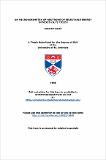Files in this item
On microdosimetry of neutrons of selectable energy in mixed (n,y) fields
Item metadata
| dc.contributor.advisor | Watt, D. E. | |
| dc.contributor.author | Saion, Elias bin. | |
| dc.coverage.spatial | 219 | en_US |
| dc.date.accessioned | 2012-06-05T10:28:15Z | |
| dc.date.available | 2012-06-05T10:28:15Z | |
| dc.date.issued | 1989 | |
| dc.identifier.uri | https://hdl.handle.net/10023/2640 | |
| dc.description.abstract | Biological damage of tissue due to intermediate energy neutrons is generally known to be very important in radiobiology and radiation protection. However, there is no suitable method to determine the quality of these neutrons in particular in the working environment of mixed (n,y) radiation fields. In this thesis, an attempt is made to develop a dosimeter based on microdosimetric principles which has the capability for such a purpose. With this object the basic concepts of microdosimetry are reviewed and discussed with emphasis on their application for radiation protection and in designing of the dosimeter. Microdosimetry based on low pressure tissue-equivalent proportional counters (TEPCs) is a powerful technique for determining microscopic distributions of energy deposition and quality of ionizing radiations. However the energy deposition spectra of intermediate energy neutrons in mixed fields of fast neutrons can only be measured using TEPC in co-axial double cylindrical form by an appropriate choice for the thickness of the common tissue-equivalent (TE) dividing wall separating the inner and outer counters and by appropriate use of coincidence/anti-coincidence pulse arrangements. An analytical calculation for the response of the inner counter operating in coincidence/anti-coincidence modes with the outer counter was developed. However there will be some events, due to fast neutrons, which will contribute to the signals from intermediate energy neutrons and which cannot be removed by anti-coincidence. For these analytical corrections must be made. Also, the events associated with the dividing wall inherent in the system can contribute to the response of the inner counter and must be corrected by calculation. The calculation was possible due to the fact that recoil particles from intermediate energy neutron interactions have effective stopping powers and projected ranges which differ significantly from the continuous slowing down approximation (CSDA) values. By incorporating these the basic CSDA formulae for energy deposition spectra of neutrons could be extended down to intermediate energy neutrons of about 1 keV. A prototype co-axial double cylindrical TEPC capable of separating the component of neutrons (≤ 850 keV) in mixed (n,y) radiation fields was manufactured and tested. The thin wall dividing the inner and outer counters was fabricated from the standard A-150 TE plastic with the thickness equivalent to the range of 850 keV protons. The operational characteristics of the dosimeter were studied to determine its applicability for use in microdosimetry. The gas gain of the inner and outer TEPCs was measured at various simulated mean chord lengths and applied voltages. The results can be expressed according to Campion's equation within a given range of the electric field strength. The resolution of the inner TEPC measured at the operating voltages is in agreement with the theoretical prediction. A series of microdosimetric experiments were performed with mixed fields of 60Co gamma-rays and neutrons from the UTR-300 nuclear reactor and from 252Cf and 241Am-Be radioactive sources. Discrimination against fast neutrons of energy > 850 keV was achieved using an anti-coincidence unit specially designed for better efficiency of data acquisition. Discrimination against fast electrons due to photon interactions was also achieved. Spectra with anti-coincidence are dominated by slow protons and electrons. Their mean lineal energies are higher than those of spectra without anti-coincidence. The quality factor and dose equivalent for spectra with anti-coincidence are higher than the spectra without anticoincidence indicating the importance of intermediate energy neutrons in mixed fields. The quality factor and the corresponding dose equivalent corrected for saturation of lineal energy corresponding to 2 nm of ionization spacing is consistently higher than those derived from the absorbed dose based formulae, the biophysical implications of which are discussed. Suggestion for future developments for microdosimetry of intermediate energy neutrons in mixed fields are made and discussed. | en_US |
| dc.language.iso | en | en_US |
| dc.publisher | University of St Andrews | |
| dc.subject.lcc | QC793.5R2S2 | |
| dc.subject.lcsh | Secondary electron emission | en_US |
| dc.subject.lcsh | Particles (Nuclear physics)--Congresses | en_US |
| dc.subject.lcsh | Neutrons | en_US |
| dc.title | On microdosimetry of neutrons of selectable energy in mixed (n,y) fields | en_US |
| dc.type | Thesis | en_US |
| dc.type.qualificationlevel | Doctoral | en_US |
| dc.type.qualificationname | PhD Doctor of Philosophy | en_US |
| dc.publisher.institution | The University of St Andrews | en_US |
This item appears in the following Collection(s)
Items in the St Andrews Research Repository are protected by copyright, with all rights reserved, unless otherwise indicated.

